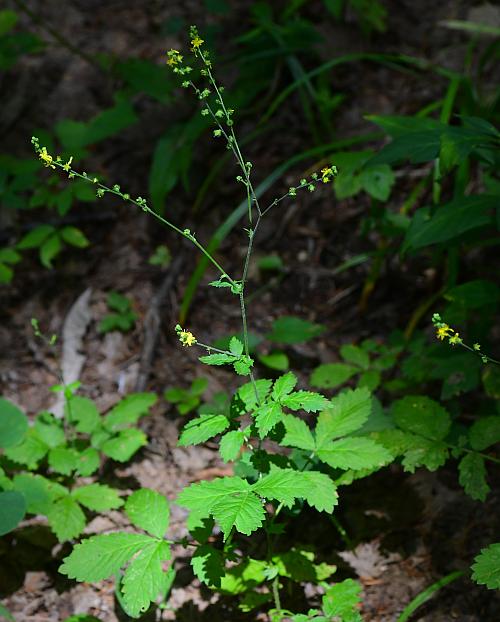Agrimonia rostellata Wallr.
Woodland Agrimony

Native
CC = 4
CW = 3
MOC = 74
© SRTurner
Agrimonia rostellata Wallr.Woodland Agrimony | |
 |
Native CC = 4 CW = 3 MOC = 74 |
© SRTurner |
|
Family - Rosaceae Habit - Perennial forb with both fibrous and tuberous-thickened roots. Stems - Ascending to erect, to 100 cm, glandular and sparsely pubescent with short, ascending and long, spreading hairs, especially toward the base.
Leaves - Alternate, pinnately compound, short-petiolate, stipulate. Stipules leaflike, fused to the petiole near the base, coarsely toothed. Blades to 20 cm long, the primary (larger) leaflets 3-9, these 1.5-10.0 cm long, mostly elliptic or obovate, narrowed or tapered to a bluntly or sharply pointed tip, the margins with mostly relatively blunt teeth, the upper surface glabrous or nearly so, the undersurface glandular and often also sparsely pubescent with short, appressed and long, spreading hairs along the veins.
Inflorescence - Terminal, spikelike racemes, the flower stalks very short, each subtended by a small deeply lobed bract, the hypanthium also subtended by a pair of inconspicuous 3-lobed bractlets. Inflorescence axis glandular and usually also with sparse to moderate, short, ascending hairs toward the base, occasionally also with sparse, longer, spreading hairs, but these 1 mm or shorter, mostly shorter than the width of the axis at the attachment point.
Flowers - Perigynous, the hypanthium appearing obconic, deeply cup-shaped with a nectar disc nearly closing the opening, armed with dense hooked bristles toward the rim, developing 10 longitudinal ridges and grooves as the fruits mature. Sepals 5, short, oblong-elliptic, spreading at flowering, becoming erect or somewhat incurved with age and developing into a small beak on the fruit. Petals 5, 2-6 mm long, broadly elliptic to nearly circular, yellow. Stamens 5-15. Pistils 2 per flower. Ovaries superior, hidden in the hypanthium, with 1 ovule. Style 1 per ovary, terminal, the stigma somewhat 2-lobed.
Fruits - Formed from the hardened obconic hypanthium, ringed with hooked bristles which aid in dispersal. Fruiting hypanthium 2.0-2.5 mm long (fruits 3.5-4.5 mm long), glandular, glabrous.
Flowering - July - September. Habitat - Forests, savannas, margins of glades, ledges and tops of bluffs, streambanks. Origin - Native to the U.S. Lookalikes - Other species of Agrimonia, especially A. gryposepala and A. pubescens. Other info. - This species is common throughout most of Missouri, but is apparently rare or absent in several counties in the northwest region of the state. It ranges throughout most of the Midwest. It is recognized by its pinnately compound leaves with rounded and toothed leaflets, and wandlike inflorescences of yellow flowers, these quickly giving rise to the burlike fruits. A. rostellata is very similar to another species, A. pubescens, but the latter is more pubescent and lacks the glands on the inflorescence axis and abaxial surface of the leaves. Another lookalike, A. gryposepala, has much larger fruits. The fruits of all of the agrimonies will accompany the woodland hiker hither and yon, velcroed to her apparel. Photographs taken in Brown Summit, NC., 7-13-02 (DETenaglia); also at Victoria Glade, Jefferson County, MO, 8-5-2016, and Glassberg Conservation Area, Jefferson County, MO, 8-5-2020 (SRTurner). |